Flavian Era (69 - 96 AD)
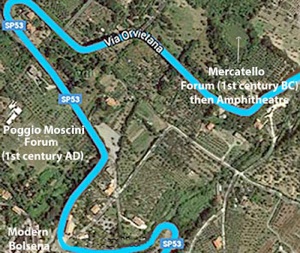
Aerial view, with modern Bolsena at the lower left
The original forum of Vosinii at Mercatello was later the site of the amphitheatre,
and site of the ‘Flavian’ forum is now the Archeological Area at Poggio Moscini
This era seems to have been a period of dramatic urban redevelopment at Volsinii. According to Pierre Gros (referenced below, 1981, at p. 28):
-
“The second half of the 1st century AD ... [witnessed] the establishment of
-
-a large forum at ... Poggio Moscini [now the Archeological Area, at the centre left in the aerial view above]; and
-
-the construction of an amphitheatre on Mercatello [the site of the original forum,, at the upper right in the aerial view above].
-
The two events are undoubtedly linked, though not exactly contemporary: the descent ... of the city centre towards the lower terraces rendered the terrace of the original forum a little bit eccentric, but it [was a suitable site for] the construction of a massive structure [to serve as a traditionally peripheral amphitheatre] ...” (my translation).
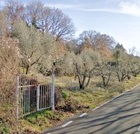
Amphitheatre
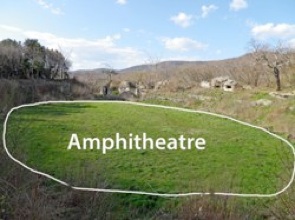
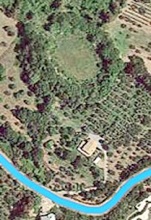
Site of the excavation at località Mercatello Aerial view
with the arena picked out with Via Orvietana marked in blue
The results of the first excavation of the amphitheatre at località Mercatello were published by Ettore Gabrici (referenced below, at p. 78) in 1906, and further work was carried out in 1988-90. Jean-Paul Thuillier (referenced below, at p. 600) observed that:
-
“Thanks to [these] excavations ... and, in particular, to the coins found here, it is likely that the amphitheatre was built in the 2nd half of the 1st century AD and restored by the middle of the 3rd century” (my translation).
An note 17, he referred to a coin from the short reign of Galba in 69 BC that broadly dated the original construction and another from the reign of the Augusta Julia Cornelia Paula (219-20 AD) that broadly dated the restoration.
Pierre Gros (referenced below, 2013, pp. 103-4) observed that the amphitheatre had:
-
“... without doubt at the end of the Flavian era, which was the most active period of construction that Volsinii knew in the imperial period. Its perfectly symmetrical structure is characteristic of the monuments that were constructed in Italy on the model of the Colosseum in Rome [which was built in 72-80 AD and modified in the reign of Domitian (81-96 AD)], and its dimensions (100.65 x 84.15 m overall, with an arena of 58.65 x 42.61 m)assured it a place among the most important of the region (smaller than that at Arezzo ... and bigger than those at Sutri and Rusellae)
Flavian Forum
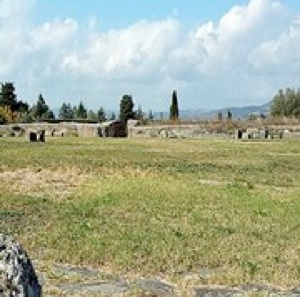
The new forum (now the Archeological Area, on a lovely terrace above the modern city and Lake Bolsena) was in the form of a paved rectangle of 70 x 105 meters, but only its southern section has been excavated. Indentations in the original paving reveal the existence in the forum of a number of small altars, bases of statues, and honorific inscriptions (some of which are described below).
Basilica Forense
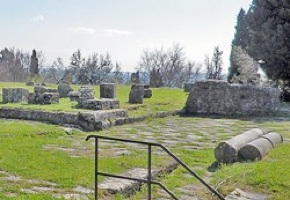
Remains of the basilica forense at the northern end of the Flavian forum
The later apse of the basilica can be seen to the right, encroaching on the road behind it
The basilica in the forum, which closed it off the northern end of the forum, must have been one of the most important buildings in the city. It was in the form of a rectangle that was much wider than it was long (60 x 25 meters). Its interior was divided by colonnades along its length into a nave and flanking aisles, which were reached from the forum by means of three covered flights of steps. An ionic capital from the facade survives in the archeological area (illustrated in this page in the website ‘Bolsenanews’ ). The basilica, which probably had a civic function, was transformed in the 4th century, as described in the next page.
New Cult Building in the Forum ?
Pierre Gros (referenced below, 2013, at pp. 98-9) conjectured that there must have been a correspondingly impressive building at the un-excavated end of the forum, opposite the civic structure described above. He further suggested that this was probably a religious building, albeit that the absence of epigraphic evidence precluded any certainty about the particular cult to which it was dedicated. Given its location, this putative temple could well have been dedicated to the imperial cult.
Did Volsinii become a Flavian Cult Site ??
As noted above, the new amphitheatre in Volsinii was apparently modelled on the Colosseum in Rome:
-
✴the Emperor Vespasian had begun work on this unprecedented structure in 72 AD;
-
✴his son, the Emperor Titus, dedicated it eight years later; and
-
✴his brother, the Emperor Domitian, probably completed the project after Titus’ death in 81 AD.
Nathan Elkins (referenced below) has shown that the Colosseum was, inter alia:
-
“... a venue for processions and images of: the gods; divi and divae [mostly deified emperors and empresses]; and the living emperor. The political and ideological significance of emperor worship and its role in presenting Titus and Domitian as successors of ... their deified father, Vespasian, must be added to the litany of ideologies conveyed by the Colosseum. The new emperor, Titus, presided over the most extensive series of games held in Rome up to that time when he inaugurated the amphitheatre .... Before the spectacles began, he sat across from a shrine bearing images of the gods and the divi [deified emperors], and he observed the sacrifices and rituals performed before them. The immense crowds that gathered to view Titus’s games also witnessed these events, and were [thus] reminded of the superhuman status of their ruler and benefactor”.
There was probably an imperial estate near Volsinii at this time, so Domitian might well have visited the city, at least occasionally. This leads to the following possibilities:
-
✴Perhaps the new amphitheatre at Volsinii was associated with the new dynastic Flavian cult that Domitian inaugurated for his deified father and brother ??
-
✴The centre of the cult in Rome was the Templum Flaviae Gentis, which Domitian built on Quirinal Hill. Could the putative temple in the new forum of Volsinii (above) have had a similar function ??
The following extracts from Suetonius’ biography of the Emperor Domitian describe his veneration of Minerva and Fortuna, and thus, presumably, of Nortia. They could therefore explain why he might have chosen Volsinii as a centre for his dynastic cult:
-
“[The Emperor Domitian ...] celebrated the Quinquatria [a festival sacred to Minerva] ... every year ... at his Alban villa, and established for her a college of priests, from which men were chosen by lot to act as officers and give splendid shows of wild beasts and stage plays, besides holding contests in oratory and poetry” (para. 4.4).
Describing the portents of Domitian’s impending assassination, Suetonius reported that:
-
“Fortune of Praeneste [Fortuna Primigenia] had throughout his whole reign, when he commended the new year to her protection, given him a favourable omen and always in the same words. Now at last she returned a most direful one, not without the mention of bloodshed. He [also] dreamed that Minerva, whom he worshipped with superstitious veneration, came forth from her shrine and declared that she could no longer protect him, since she had been disarmed by Jupiter”.
It must be stressed that the possible Flavian cult site at Volsinii is purely my conjecture: there is no direct evidence for it of any kind. ( Lammert Bouke van der Meer, referenced below, has put forward a similar suggestion for a temple at Ostia, but he could point to epigraphic evidence for the presence of an associated priesthood in that city). Nevertheless, if the hypothesis could be proved for Volsinii, it would have a central bearing on subsequent events here.
Emperor Trajan (98-117 AD)
The most important development at Volsinii at this time was the completion of the Via Traiana Nova, in ca. 108 AD.
Inscribed Milestone (107 AD)
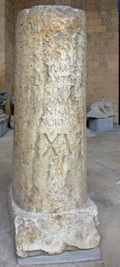
Imp(erator) Caesar / Divi Nervae f(ilius)
Nerva Traianus / Aug(ustus) Germ(anicus) Dacicus
pont(ifex) max(imus), trib(unicia) pot(estate) XII
[i]mp(erator) VI, co(n)s(ul) V, p(ater) p(atriae)
Viam Novam [Tra]ia[n(i)]
a Volsinis ad fines / Clusinorum fecit/ XVII
Funerary Inscription (ca. 100 AD)
This inscription (CIL XI 2706; EDR 127097) in the loggia of Palazzo Soliano, Orvieto was discovered in 1881 during excavations in Piazza Grande, of Castel Viscardo (see the map on the previous page). It reads:
D(is) M(anibus) / Ulpiae Terpsidi
Securus Aug(usti) disp(ensator)
coniugi / bene /merenti
et Hilarus fil(ius)
matri / pientissimae
It commemorates a freed slave, Ulpiae Terpsidi, the well-deserving wife of Securus and pious mother of Hilarus. Securus (who was still a slave) held the post of imperial dispensator (treasurer). Francis Tassaux (referenced below) suggested that:
-
“... in all likelihood Ulpiae had been a freed woman of the Emperor Trajan” (my translation).
This is one of five inscriptions that he cited as evidence of an imperial estate near Volsinii.
Antonine Period (138-92 AD)
Imperial Inscriptions
Six inscriptions commemorating members of the Antonine dynasty have been found in Bolsena. They were widely scattered but, as Philippe Mauget (referenced below) has suggested, many of them were probably originally in or near the forum.
Marcus Aurelius (ca. 175 AD)
This inscription (CIL XI 02693, EDR 126349), which was discovered in the cemetery of Santa Cristina, is now in the sacristy there:
[I]mp(eratori) Caes(ari) divi Antonini Pii fil(io) divi Veri Parthic(i)/ Maximi
fratri divi Hadriani nepoti divi Traian[i]
Parthici pronep(oti) divi Nervae abnepoti
M(arco) Aurelio/ Antonino Aug(usto) Germ(anico) Sarm(atico)
pont(ifici) maximo
trib(unicia) pot(estate) [XX...] / imp(eratori) VIII co(n)s(uli) III p(atri) p(atriae)
Marcus Aurelius
This inscription (CIL XI 02694, EDR 126828), which was discovered in the pavement of Santa Cristina, is now in the sacristy there:
[--- Divi Antonini] Pii fil(io) [...]
[...] M(arco) Aureli[o ...]
[...] Aug(usto) po[nt(ifici)
Marcus Aurelius and Lucius Verrus
These fragmentary inscriptions (AE 1979, 0204/5; EDR 077362 and EDR 077363) from an unknown location in Volsinii (now in Casa Paparozzi) read:
Imp(eratori) Caesar[i di]vi / Antonini filio
[di]vi / Hadriani nepot[i
[di]vi / Traiani Parthic[i pronep(oti)]
divi Nervae abn[epoti]
[M(arco) A]ur[elio Antonino Aug(usto)]
and:
Imp(eratori) Caesar[i di]vi / Antonini filio
[di]vi / Hadriani nepot[i
[di]vi / Traiani Parthic[i pronep(oti)]
divi Nervae abn[epoti]
L(ucio) Aurelio Vero Augusto
The large size of these marble fragments suggests that they came from the base of a statue (perhaps an equestrian statue) of the two emperors.
Faustina
This inscription (CIL XI 7279, AE 1904, 0041, EDR 071985) from Poggio Moscini, read:
Div[ae] / Fau[stinae]
Imp(eratoris) C[aesaris] / T(iti) Aeli [Hadriani] / Anto[nini Aug(usti)] / Pii
p(atris) [p(atriae)]
d(ecreto) d(ecurionum)
Commodus (180 - 92 AD)
This inscription (CIL XI 7280, EDR 136400) was found in Castiglione in Teverina, in the vicinity of Madonna delle Macchi:
Impera]toris Ca[es(aris) ...] / [... C]ommo[di ...] / [... Aug]usti
Because of the lacunae, it is impossible to tell whether the inscription contained a reference to Commodus’ deification by Septimius Severus (below) in 193 AD. Commodus had been assassinated in the previous year and his memory had been damned. If the statue and its base pre-dated 193 AD, they might well have been hidden at the time of their damnation to avoid their destruction and perhaps subsequently returned to their original location.
Praetor Etruriae XV Populorum
Pompeius Vopiscus Arruntius Catellius Celer (ca. 150 AD)
-
This inscription ((AE 1980 0426) from Poggio Moscini, which was published by Pierre Gros, (referenced below, 1980) came from the base of a statue of a man from Volsinii that had been dedicated by his clients from the city of Carthage:
-
[--- Pompeio - f(ilio) Pom(ptina) Vopisco C(aio) Arr]unt[io Cate]llio Celeri Allio Sabino
-
[Xvir(o) stlitib(us) iudicand(is)] t[rib(uno) lati]cla[vio leg(ionis) ---] p(iae) f(idelis) quaestori candidat(o) Aug(usti)
-
[trib(uno) pleb(is) praetori ---]N[--- leg(ato)] le[g(ionis) XIIII] gem(inae) et leg(ionis) I Italicae dd. militarib(us)
-
[donato ab Imp(eratore) Caesare divo Hadriano Au]g(usto) ha[sta] pura coron(a) vallari vexill(o) arg(enteo) legat(o)
-
[Imp(eratoris) Caesaris Antonini Aug(usti) Pii provinc(iae) Cappad]oc(iae) aug[ur]i co(n)s(uli) pr(aetori) Etruriae proco(n)s(uli) provinc(iae) Africae
-
[patrono col(onia) I]ulia Carthago
Unfortunately, the first part of the subject’s name is missing: what remains is [...] Vopiscus C. Arruntius Catellius Celer, son of Pompeius, of the Pomptina tribe. He might have been:
-
✴a descendent of L. Pompeius Vopiscus C. Arruntius Catellius Celer, who was a suffect consul in 77 AD; and
-
✴related to the subject of another inscription (AE 1980 0427 ) from Bolsena , Q. Pompeius Vopiscus ... Catellius Celer A...
Pierre Gros (referenced below, 1980, at p. 986) constructed the cursus of this man, which included the following important posts:
-
✴legatus Augusti pro praetore (imperial legate) to Cappadocia in ca. 138-9 AD;
-
✴suffect consul in ca. 140-2 AD; and
-
✴proconsul of Africa in 155-6 AD.
The post of praetor Etruriae is included within what seems to be an ascending order of offices, allowing Marco Ricci (referenced below, at p.10, entry 11) to date his term of office as praetor Etruriae to the period 140-156 AD. The statue had been dedicated by the Colonia Julia Carthago (Carthage), of which Pompeius Vopiscus was patron.
This inscription is catalogued in the page on the Revived Etruscan Federation.
3rd Century
Caracalla and Julia Domna (211 AD)
This inscription (CIL XI 02696, EDR 126961) in which the Senate and people of Volsinii honoured the Emperor Caracalla and his mother, Giulia Domna, was found in the cemetery of Santa Cristina and is now in the sacristy there:
Imp(eratori) Caes(ari) divi Septimi Severi Pii
Arab(ici) Adiab(enici) Parthici maximi / Britannici maximi filio
divi/ M(arci) Antonini Pii German(ici) Sarm(atici) nep(oti)
divi Antonini Pii pronep(oti)
divi Hadriani abnep(oti)
divi Traiani Parthic(o) divi Nervae adnepoti
Imp(eratori) M(arco) Aurelio Antonino Pio Aug(usto) Britann(ico)
max(imo) pont(ifici)
max(imo) trib(unicia) pot(estate) XIIII
imp(eratori) II co(n)s(uli) III
proconsuli p(atri) p(atriae)
Senatus populusque Vo[lsini]ens(is)
[....]
Iuliae Aug(ustae)/ matri Aug(ustorum)
et castro[r(um) et] / sen[atus ...]
Caracalla’s brother Geta, whom he murdered in December 211 AD, might have been commemorated in the original inscription. Any such reference would have been quickly expunged at the time of his murder, perhaps replaced by the dedication to Giulia Domna. In this case, his statue would have been destroyed (or perhaps hidden so that this could be avoided).
Caracalla seems to have felt the need to dwell on the number of his deified ancestors, presumably because of the sensitivity about his position. In fact, only one of them, his father Septimius Severus, had been a blood relation. The others could be claimed only because Septimius Severus had “adopted” the dead Commodus (above) as his brother in 193 AD. This allowed him, and thus his sons, to “claim” the other Antonine emperors as deified ancestors. Poor old Commodus does not make it into Caracalla’s list, despite the fact that he was technically Caracalla’s deified uncle.
Praetores Etruriae
Two inscriptions from Volsinii commemorate now-anonymous praetores Etruriae one of which certainly and the other of which probably dates to the 3rd century AD:
-
✴An inscription (CIL XI 2699) [now in Palazzo del Drago, Bolsena ??] reads:
-
[....]
-
tr(ibuno) p]l(ebis?) candi[d(ato) quaest(ori) patrono]
-
in Italia Volsiniensium patriae suae,
-
item Ferent(inatium) et Tiburtium
-
item colon(iae) Italicens(ium) in prov(incia) Baetica
-
praet(ori) Etrur(iae) XV populor(um)
-
sacerdoti Caeninensium
-
M(arcus) Helvius M(arci) f(ilius) Clemens Arnen
-
sis(!) domo Carthagine praef(ectus) eq(uitum)
-
alae primae Cannanefat(i)um
-
praesidi sanctiss(imo) et rarissimo cura agente
-
L(ucio) Aconio Callisto
-
trib(uno) mil(tum) leg(ionis) XIIII Gem(inae) Sev(erianae)
-
The subject was of equestrian rank (since he had held the Roman priesthood of sacerdoti Caeninensium). Mario Torelli (referenced below) believed that he had probably been the Roman governor of Pannonia Superior. He was a patron of his native city and also of Ferentium, Tibur and Italica (a colony in modern Spain).
-
His statue had been dedicated by:
-
✴Marcus Helvius Clemens, a native of Carthage and Cavalry Commander of an auxiliary regiment, the 1st Cannanefatium; and
-
✴Lucius Aconius Callistus, Miltary Tribune of the 14th Legion under the Emperor Severus Alexander (222-35 AD), a man known from other inscriptions in Volsinii.
-
✴An inscription (CIL XI 7287 = AE 2000, 00136 = AE 1904, 0038) that was published by Ettore Gabrici in 1903, in a report of his then-recent excavations) [where is it now ?], read:
-
[--- praetori]/ XV populor(um)
-
c[uratori]/ [t]empl(i) deae N[ortiae
-
patrono]/ [c]oloniae I[talicensium? ---]
-
The man commemorated was, like the man above, a patron of Italica. He was also the curator of a temple of the goddess Nortia (who was presumably responsible for its maintenance, decoration or restoration). (It is important to remember that, by this time, the Etruscan language had been forgotten and Etruscan deities had largely assumed Roman identities. However, the case of Nortia at Volsinii was clearly a notable exception.)
Mario Torelli (referenced below, at pp. 84-5) suggested that these two inscriptions relate to the same person, and that he was probably a member of the Rufi Festi family (like Rufius Festus, Avienus, the author of the “Carmen ad Nortiam” in Rome). Annalisa Calapà (referenced below, at p. 42) summarised:
-
“If both inscriptions refer to the same person, as is generally believed, it can be assumed that this Rufius Festus had restored or refurbished the temple of Nortia, which most probably had an important place among the Volsinian sanctuaries.”
These inscriptions are catalogued in the page on the Revived Etruscan Federation.
Other prominent Volsinians retained their association with Nortia in her Etruscan form into the 4th century AD. Thus the ‘Carmen ad Nortiam’ (CIL VI 537) on what was probably the tomb in Rome of the Volsinian poet, Postumius Rufius Festus, Avienus:
R(ufius) Festus v(ir) c(larissimus) de se ad deam Norti[am]
Festus Musoni suboles prolesque Avieni,
unde tui latices traxerunt, Caesia, nomen,
Nortia, te veneror lare cretus Vulsiniensi,
Carlos Machado (referenced below, at p. 335) reproduced the following translation:
-
“Rufius Festus, vir clarissimus, to the goddess Nortia about himself: ... I [Festus], a native of Vulsinii, domiciled at Rome, worship you.”
Machado commented (at p. 336):
-
“The antiquarian nature of the inscription established Festus’s identity in a way that the mere reference to Volsinii would not have been able to do. In other words, not only his family roots but also his religious identity were located in a distant past and in a different city.”
Earthquake of 242 AD and the Temple of Nortia
Ettore Gabrici discovered another inscription (CIL XI 7281) during his excavations of 1903, which honoured the Emperor Gordian III. It has been reconstructed from a number of fragments as:
[In honor]em d(omini) n(ostri) G[ordini Pii Felicis Aug(usti)]
[... toti]usque [domus] d[ivinae ...]
[...] vindicta [...]
[...] Umbria [...]
[...]ation[...] / [...]oru[m ....]
[...]II[ // ]/TI[...] / dis[...]
labe[factatam ... v]iol[entia(?) ...]
et popul[i ... pecu]nia c[onlata ... ad ...]m
priore[m ... re]staurab[erunt
Luigi Sensi (referenced below) made three interesting observations about this inscription:
-
✴Following Bormann, he suggested that the word “Umbria” probably referred to the Umbrian participation in the annual pan-Etruscan festival held at Volsinii (as evidenced by the Rescript of Hispellum, discussed on the following page).
-
✴The phrase “labe[factatam ... v]iol[entia(?)” (damaged by violence?) might have referred an earthquake that was documented for the reign of Gordian III:
-
“There was a severe earthquake in Gordian's reign - so severe that whole cities with all their inhabitants disappeared in the opening of the ground. Vast sacrifices were offered through the entire city [of Rome] and the entire world because of this. And Cordus says that the Sibylline Books were consulted, and everything that seemed ordered therein done; whereupon this world-wide evil was stayed. But after this earthquake was stayed, in the consulship of Praetextatus and Atticus [242 AD], Gordian opened the twin gates of Janus, which was a sign that war had been declared, and set out against the Persians ...” (‘Historia Augusta’, 26).
-
✴Given that this inscription was found in the same place as the inscription (above) that records the possible restoration of a Temple to Nortia, we might reasonably assume that the restoration of the temple had been necessitated by this earthquake.
In short, if the subject of CIL XI 2699, whose statue had been dedicated in the reign of Severus Alexander (222-35 AD), was also the subject of CIL XI 7827, then there is at least circumstantial evidence to suggest that he subsequently restored the Temple of Nortia at Volsinii after the earthquake of 242 AD.
Enrico Zuddas (referenced below, at pp, 226-7) after a discussion of this inscription, suggested that the performance of the rite of the Clavus Annalis at a temple of Nortia at Volsinii:
-
“... could have been reprised by the praetores Etruriae [of the revived Etruscan Federation], with reference to the function of the ancient presidents of the Etruscan league” (my translation).
I argued in the previous page that the temple in question might well have been in the sanctuary on the site of the fanum Voltumnae outside modern Orvieto, which probably belonged to Volsinii and which was linked to it by an ancient Roman road.
Restoration of the Amphitheatre (mid- 3rd century AD)
As mentioned above, the results of the first excavation of the amphitheatre at località Mercatello were published by Ettore Gabrici (referenced below, at p. 78) in 1906, and further work was carried out in 1988-90. Jean-Paul Thuillier (referenced below, at p. 600) observed that:
-
“Thanks to [these] excavations ... and, in particular, to the coins found here, it is likely that the amphitheatre was built in the 2nd half of the 1st century AD and restored by the middle of the 3rd century” (my translation).
An note 17, he referred to a coin from the short reign of Galba in 69 BC that broadly dated the original construction and another from the reign of the Augusta Julia Cornelia Paula (219-20 AD) that broadly dated the restoration. This restoration seems to have affected only the upper tier of the amphitheatre. Jean-Paul Thuillier (referenced below, at p. 600) estimated that, thereafter, it could hold some 7,000 spectators, far more that the probable population of Volsinii at this point.
Read more:
E. Zuddas, “La Praetura Etruriae Tardoantica”, in
A. Cecconi and A. Raggi (Eds), “Epigrafia e Società dell’ Etruria Romana (Firenze, 23- 24 ottobre 2015)”, in course of publication
I am grateful to Dr Zuddas for sending me a copy of his paper
N. Elkins, “The Procession and Placement of Imperial Cult Images in the Colosseum”, Papers of the British School at Rome, 82 (2014) 73-107
M. Ricci, “Praetores Etruriae XV Populorum: Revisione e Aggiunte all’ Opera di Bernard Liou”, Bollettino della Deputazione di Storia Patria per l’Umbria, 111:1(2014) 5-30
G. della Fina and E. Pellegrini (Eds), “Da Orvieto a Bolsena: un Percorso tra Etruschi e Romani”, (2013 ) Pisa. In particular:
P. Gros, “La Nuova Volsinii: Cenno Storico sulla Città”, (pp 88-105)
P. Mauget, “Le Testimonianze Epigrafiche: la Nuova Volsinii”, (pp 178-86)
A. Calapà, “Sacra Volsiniensia. Civic Religion in Volsinii after the Roman Conquest”, Proceedings of the Twenty-Second Annual Theoretical Roman Archaeology Conference, Frankfurt, (2012)
C. Machado, “Religion as Antiquarianism: Pagan Dedications in Late Antique Rome”, in
J. Bodel and M. Kajava (Eds), “Religious Dedications in the Greco-Roman World: Distribution, Typology, Use”, (2009) Rome, pp. 331-44
L. Bouke van der Meer, “The Temple on the Piazzale delle Corporazioni in Ostia Antica”, Babesch, 84 (2009) 169-76
L. Sensi, “In Margine al Rescritto Costantiniano di Hispellum” in
“Volsinii e il suo Territorio”, Annali della Fondazione per il Museo ‘Claudio Faina’,
6 (1999) 365-71
M. Torelli, “Studies in the Romanisation of Italy” (1995) Edmonton (English translation)
Chapter 4, “Towards the History of Etruria in the Imperial Period”, corrects and comments on the above paper by Bernard Liou
F. Tassaux, “Pour une Histoire Économique et Sociale de Bolsena et de son
Territoire”, Mélanges de l'Ecole Française de Rome: Antiquité , 99:2 (1987) 535-61
J. Thuillier, “Les Édifices de Spectacle de Bolsena: Ludi et Munera”, Mélanges de l'Ecole Française de Rome, Antiquité, 99:2 ( 1987) 595-608
P. Gros, “Bolsena I: Scavi della Scuola Francese di Roma a Bolsena (Poggio Moscini): Guida agli Scavi”, Mélanges d' Archéologie et d' Histoire, 6 (1981)
P. Gros, “Une Dédicace Carthaginoise sur le Forum de Bolsena”, Mélanges de l'Ecole Française de Rome: Antiquité, 92:22 (1980) 977-92
E. Gabrici, “Bolsena: Scavi e Trovamenti Fortuiti”, Notizie degli Acavi (1906) 59–93
Ancient History: Velzna/ Volsinii Destruction of Velzna
Volsinii (Bolsena): Republican Period; TriumviralPeriod;
Early Empire; Imperial Period; Late Empire;
Rescript of Constantine at Hispellum (ca. 335 AD)
Return to the page on History of Orvieto.



